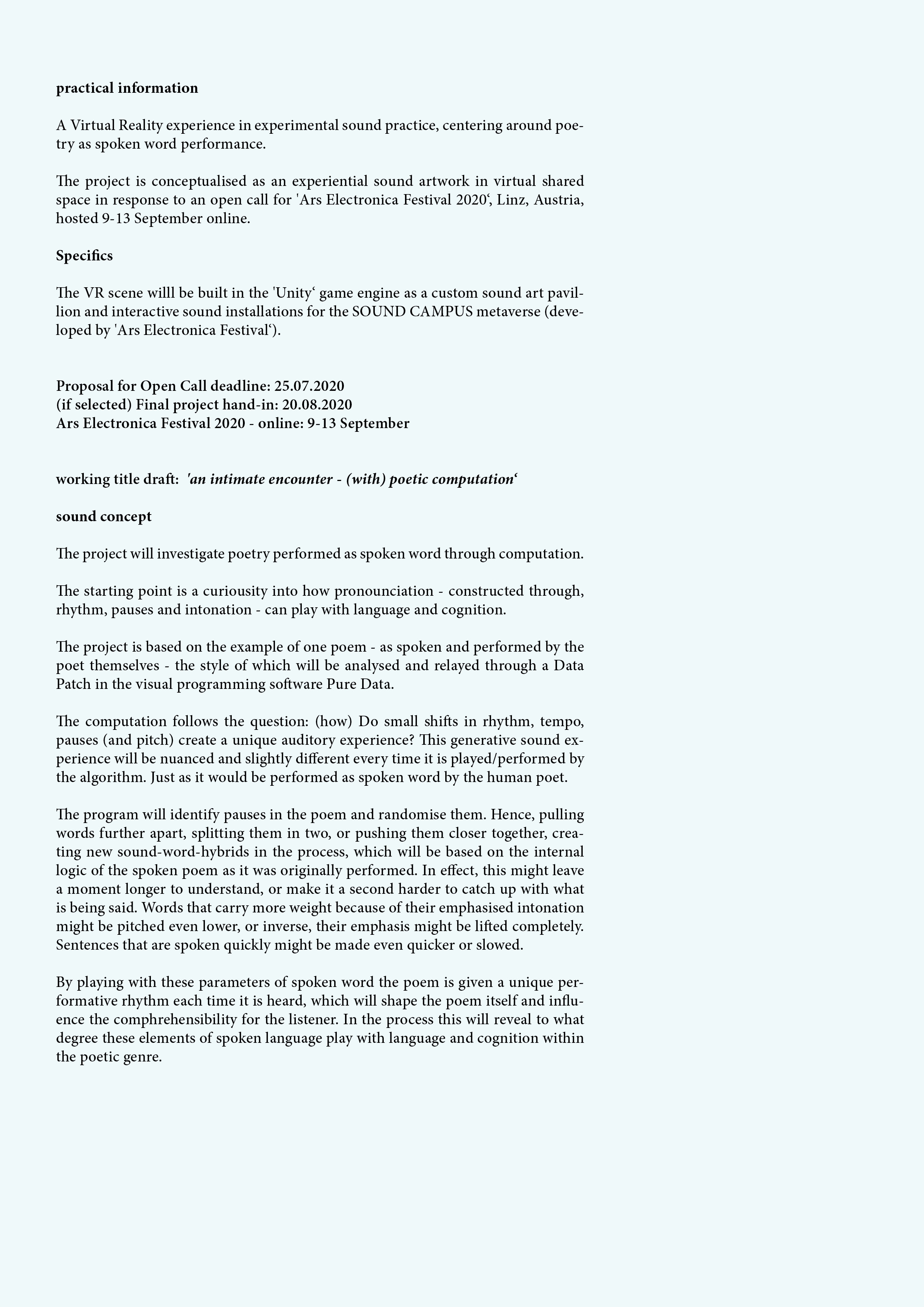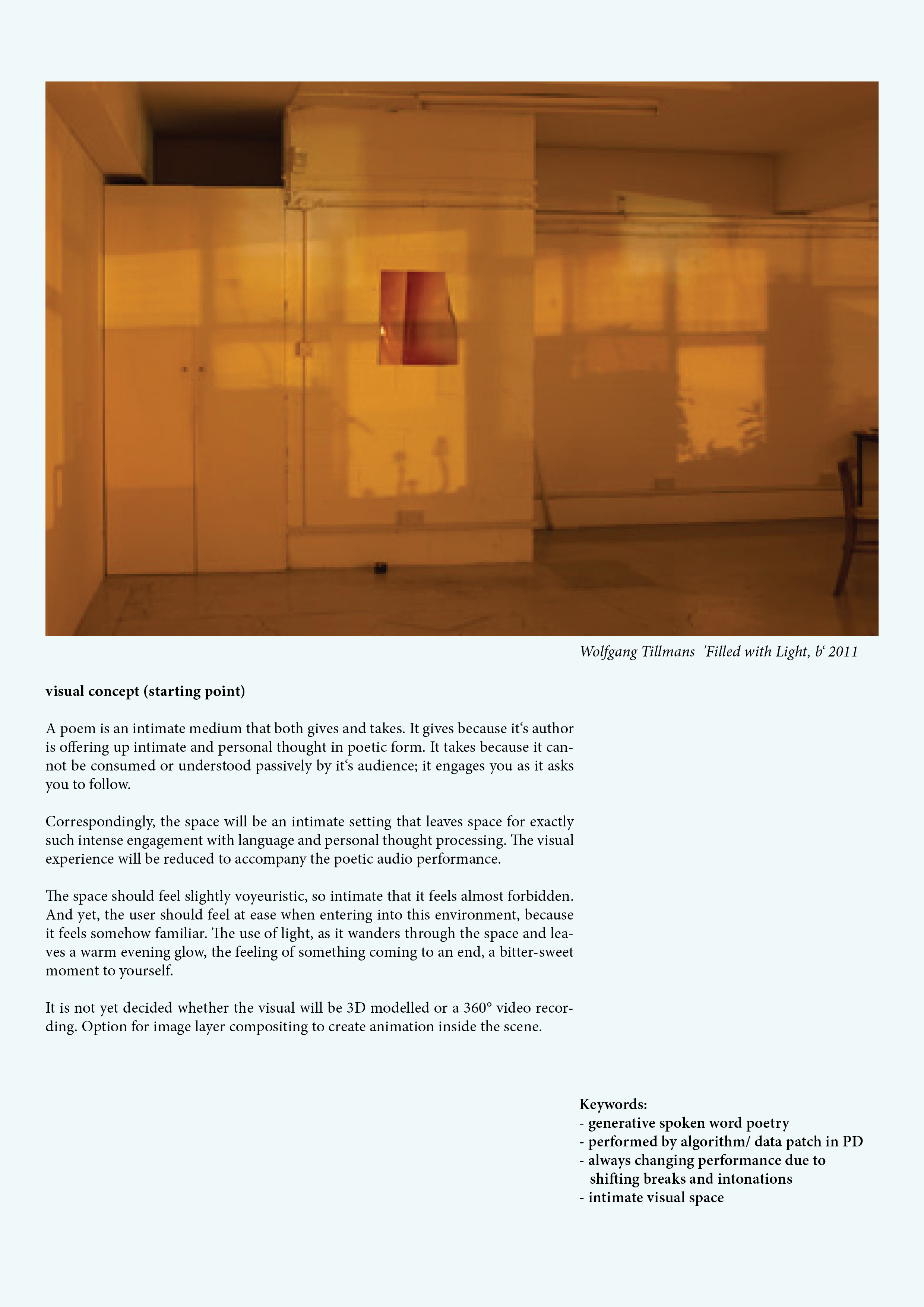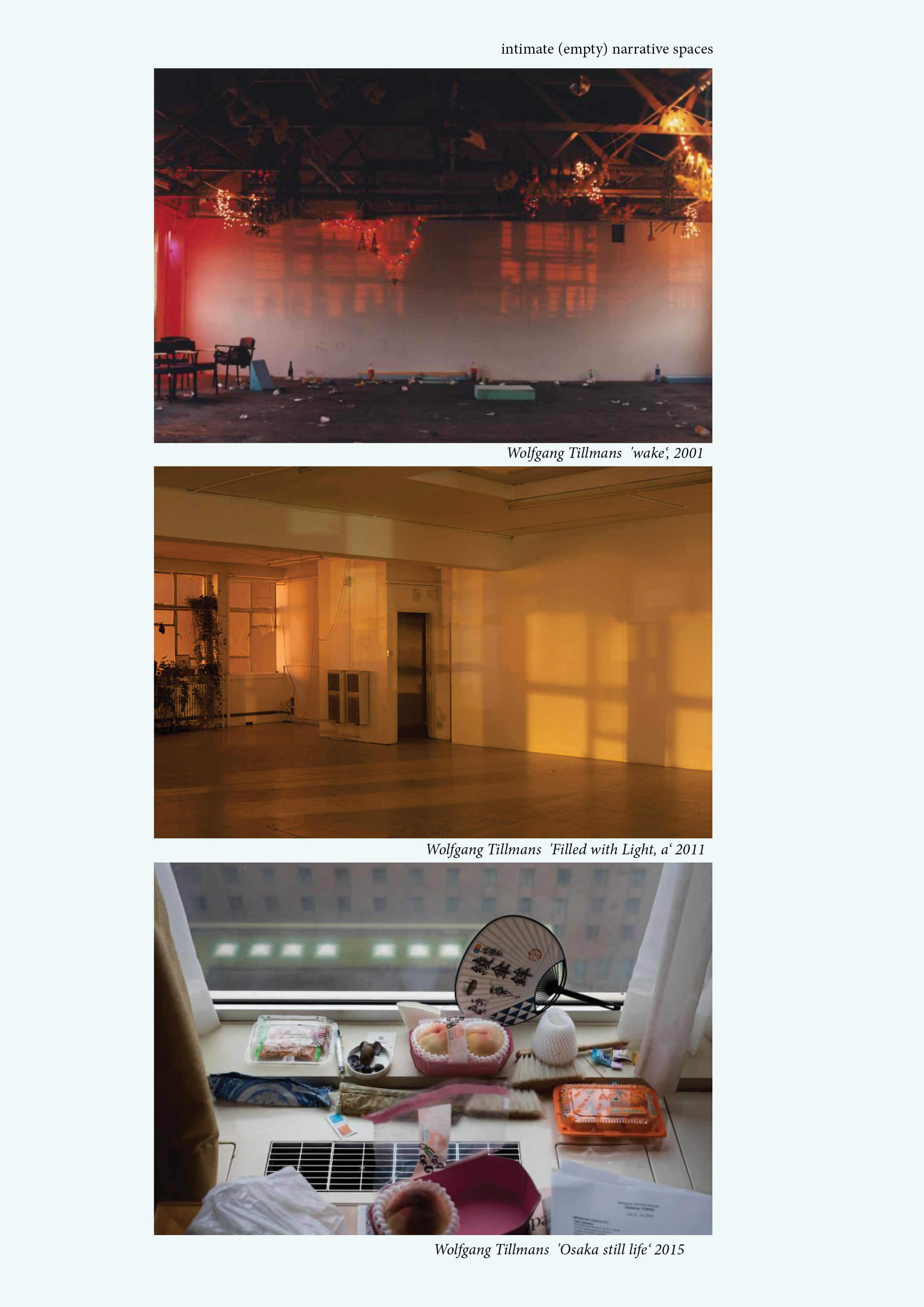mNo edit summary |
mNo edit summary |
||
| Line 13: | Line 13: | ||
The poem as originally performed by Malina at ‘drift’ in Berlin: | The poem as originally performed by Malina at ‘drift’ in Berlin: | ||
The project will translate poetry into a virtuelle, visuelle experience and investigate spoken-word poetry through computation. | |||
The starting point is a curiosity into how pronunciation - constructed through, rhythm, pauses and intonation - can play with language and cognition. | |||
The project is based on the poem ‘twist’- as spoken/presented by the poet herself- the style of which will be analysed and relayed through a Data Patch in the visual programming software Pure Data. | |||
The set-up of the patches follows the question: (how) Do small shifts in rhythm, tempo, pauses (and pitch) create a unique auditory experience? This generative sound experience is designed to be nuanced and slightly different every time it is played/performed by the algorithm. Just as it would be performed as spoken word by the human poet. | |||
The data patch will identify pauses in the poem and randomise them. Hence, pulling words further apart, splitting them in two, or pushing them closer together, creating new sound-word-hybrids in the process, which will be based on the internal logic of the spoken poem as it was originally performed. In effect, this might leave a moment longer to understand, or make it a second harder to catch up with what is being said. Words that carry more weight because of their emphasised intonation might be pitched even lower, or inverse, their emphasis might be lifted completely. Sentences that are spoken quickly might be made even quicker or slowed. | |||
By playing with these parameters of spoken word the poem is given a unique performative rhythm each time it is heard, which will (re-)shape the poem itself and influence the comprehensibility for the listener. In the process this will reveal to what degree these elements of spoken language play with language and cognition within the poetic genre. | |||
This theme of ‘sound research’ i.e. questioning how we hear speech is inspired by Diana Deutsch’s research into ‘Musical Illusions and Phantom words’ | |||
== Visual concept == | |||
The VR experience will be a slow, fully guided, visual journey of the poem ‘twist’ and position it across and within the space, hereby creating a dynamic, shifting, spatial (sound) experience. | |||
*pdf of poem | |||
The main visual components (bodies, street elements) are inspired directly by the poem. | |||
dry asphalt
| |||
my mind | |||
on this street | |||
the street | |||
pavement | |||
kerbside | |||
through the kerbstone
tongue | |||
behind your ear | |||
my mouth | |||
inside my head | |||
my brain | |||
your teeth are splitting | |||
your lips are bleeding
my fingers / your fingers | |||
my hand | |||
my eyes / your eyes | |||
my inner surface the edges transformed | |||
tongue-mouth-narrowness | |||
finger-hand-fragmentation | |||
mind-street-realisation | |||
Key-adjectives or visual phrases are selected to help further define the VR space and effects. | |||
it’s twisted | |||
are twitching | |||
are splitting | |||
are transparent | |||
opacity | |||
restless | |||
my sight | |||
was body-less | |||
alienation | |||
transcendence | |||
are distorting | |||
are blurring | |||
be sharp | |||
twisted knot | |||
We spoke about the body, about foldings and the simulacra of internal to external realities. | |||
The external symbols of the street, the kerbside, the kerbstone, the dry asphalt all serve as analogies, wherein the outside terminologies are used to illustrate an inner reality. | |||
A conversation between two people? or an internal monologue? A network of selves? A blurring, twisting, twitching back and forth between these selves. | |||
Visual concept outline: | |||
* pdf | |||
== Process: Integration of Pure Data == | |||
Patch (1) ‘ identify pauses’ and randomise them | |||
> loads audiofile | |||
> define breaks duration | |||
> identifies breaks by | |||
> randomises and extends the breaks | |||
Patch (2) identify intonation through pitch and change the pitch | |||
Patch (3) randomise tempo | |||
> specify sentences/sections where tempo can be altered | |||
Revision as of 21:48, 28 October 2020
The outset
In an effort of wanting to make the virtuell space more ‘real’ - more tangible somehow - I started out with the intention to bring ‘non-digital’ crafts into the VR space. Additionally I was introduced to the very basics of working with sound through data patches in Pure Data. This soon lead me to a poem titled ‘twist’ by Malina Heinemann. I was especially struck by her spoken word performance of the poetry, which subsequently lead me into considerations about sound, intonation, rhythm and understanding.
Collaborative Concept
The VR poem is developed in collaboration with the poet, Malina Heinemann, who lives and works in Berlin.
Sound concept
The poem as originally performed by Malina at ‘drift’ in Berlin:
The project will translate poetry into a virtuelle, visuelle experience and investigate spoken-word poetry through computation.
The starting point is a curiosity into how pronunciation - constructed through, rhythm, pauses and intonation - can play with language and cognition.
The project is based on the poem ‘twist’- as spoken/presented by the poet herself- the style of which will be analysed and relayed through a Data Patch in the visual programming software Pure Data.
The set-up of the patches follows the question: (how) Do small shifts in rhythm, tempo, pauses (and pitch) create a unique auditory experience? This generative sound experience is designed to be nuanced and slightly different every time it is played/performed by the algorithm. Just as it would be performed as spoken word by the human poet.
The data patch will identify pauses in the poem and randomise them. Hence, pulling words further apart, splitting them in two, or pushing them closer together, creating new sound-word-hybrids in the process, which will be based on the internal logic of the spoken poem as it was originally performed. In effect, this might leave a moment longer to understand, or make it a second harder to catch up with what is being said. Words that carry more weight because of their emphasised intonation might be pitched even lower, or inverse, their emphasis might be lifted completely. Sentences that are spoken quickly might be made even quicker or slowed.
By playing with these parameters of spoken word the poem is given a unique performative rhythm each time it is heard, which will (re-)shape the poem itself and influence the comprehensibility for the listener. In the process this will reveal to what degree these elements of spoken language play with language and cognition within the poetic genre.
This theme of ‘sound research’ i.e. questioning how we hear speech is inspired by Diana Deutsch’s research into ‘Musical Illusions and Phantom words’
Visual concept
The VR experience will be a slow, fully guided, visual journey of the poem ‘twist’ and position it across and within the space, hereby creating a dynamic, shifting, spatial (sound) experience.
- pdf of poem
The main visual components (bodies, street elements) are inspired directly by the poem.
dry asphalt my mind on this street the street pavement kerbside through the kerbstone tongue behind your ear my mouth inside my head my brain your teeth are splitting your lips are bleeding my fingers / your fingers my hand my eyes / your eyes my inner surface the edges transformed tongue-mouth-narrowness finger-hand-fragmentation mind-street-realisation
Key-adjectives or visual phrases are selected to help further define the VR space and effects.
it’s twisted are twitching are splitting are transparent opacity restless my sight was body-less alienation transcendence are distorting are blurring be sharp twisted knot
We spoke about the body, about foldings and the simulacra of internal to external realities. The external symbols of the street, the kerbside, the kerbstone, the dry asphalt all serve as analogies, wherein the outside terminologies are used to illustrate an inner reality.
A conversation between two people? or an internal monologue? A network of selves? A blurring, twisting, twitching back and forth between these selves.
Visual concept outline:
Process: Integration of Pure Data
Patch (1) ‘ identify pauses’ and randomise them > loads audiofile > define breaks duration > identifies breaks by > randomises and extends the breaks
Patch (2) identify intonation through pitch and change the pitch
Patch (3) randomise tempo > specify sentences/sections where tempo can be altered


